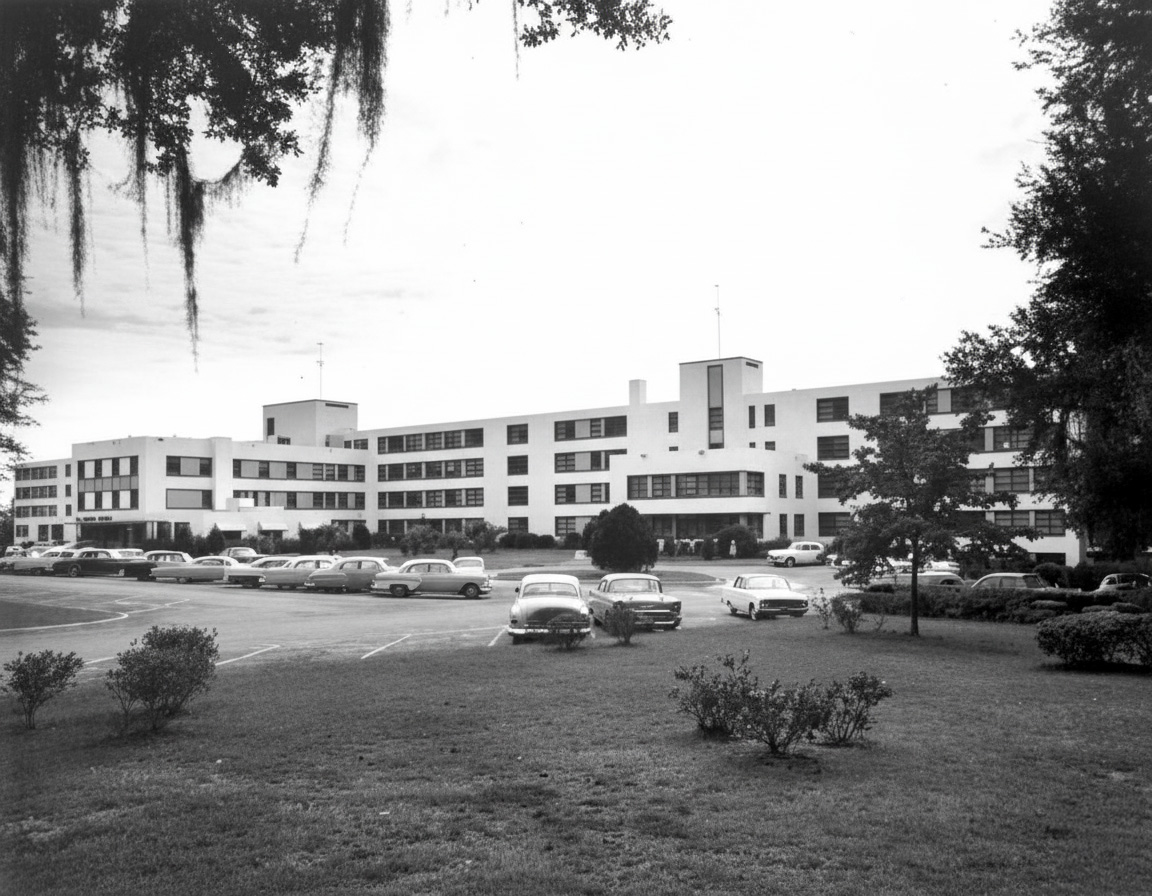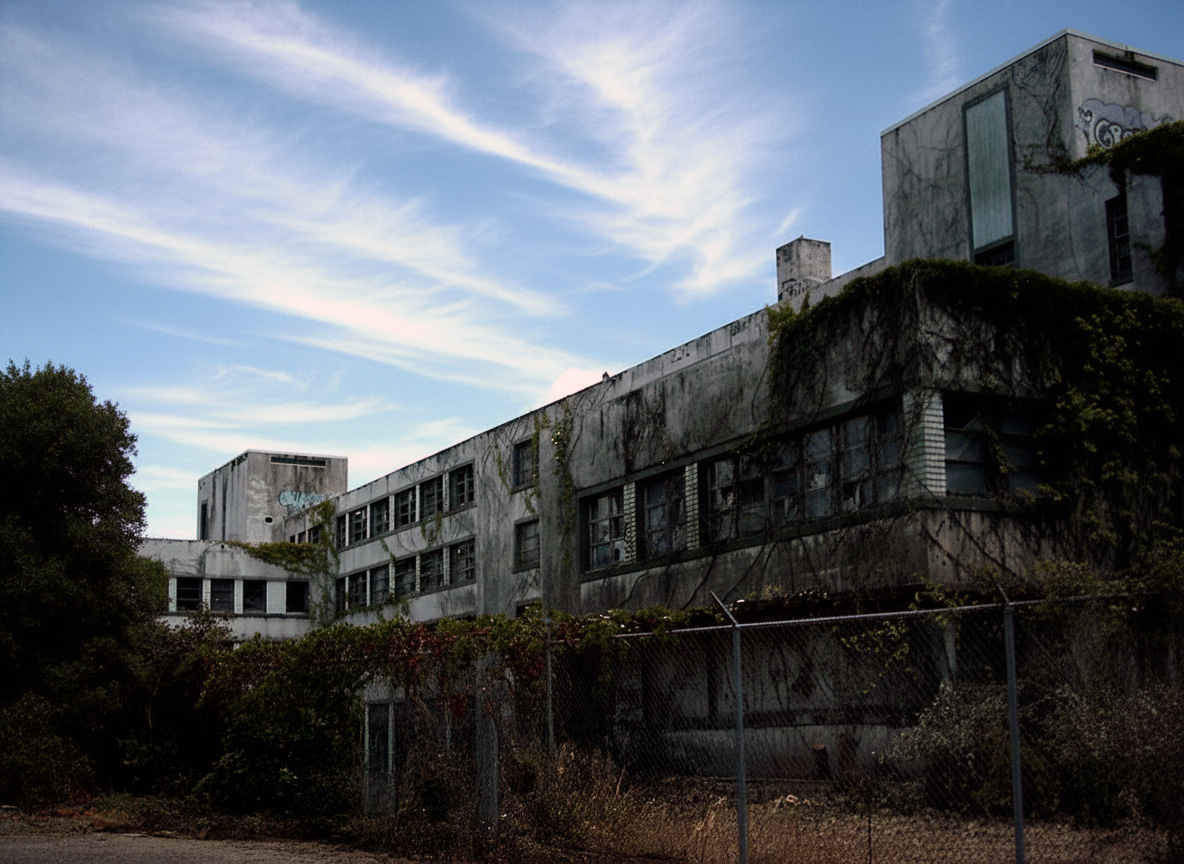The Legacy of Sunland

The site now occupied by modern apartments in Tallahassee, Florida, harbors a dark and troubled history, once the home of notorious Sunland Hospital. The state-operated facility, open for several decades, started off as a promising public health center that escalated to the status of a symbol of neglect and alleged abuse before finally shutting and becoming one of Tallahassee's premier urban legends in its final, complete demolition.
The Early Years: W.T. Edwards Tuberculosis Hospital (1952–c 1960s)
The hospital originally opened on July 1, 1952, as the W.T. Edwards Tuberculosis Hospital. It was the fifth of a line of state hospitals built specifically to treat tuberculosis. Named in honor of the first chairperson of the State Tuberculosis Board, W. T. Edwards, the hospital was modern for its time. Architecturally, the central building was long and thin, and five stories high, full of multi-pane windows, to maximize the fresh air, which was considered the best therapy for TB.
The Descent into Sunland Center (1967–1983)
With the universal success of antibiotics and vaccines against tuberculosis, the W.T. Edwards Hospital was shut down in 1966. After renovation, the hospital was reopened in 1967 as one of the statewide Sunland centers, opened to serve primarily mentally and physically disabled children. The Tallahassee center was unique among the centers because it was defined as a hospital, treating both mentally and physically disabled patients.
Despite its renewed purpose, the Sunland Center quickly became notorious. Less than a year after its opening, it suffered a lack of funds and extreme overcrowding. The Sunland Center became known as the "most infamous facility for patient neglect" in the Sunland chain of hospitals. Systemic issues included gross deterioration of the physical building, severe staff shortages, unacceptable sanitation, inadequate dental services, and inferior food preparation. One worker in 1980 recalled children being fed off the floor, which was frequently covered with urine and feces, describing the environment as "very nasty and very creepy."
The hospital's ultimate 1983 closure is attributed to a 1978 federal class-action lawsuit filed by the Association of Retarded Citizens (ARC) alleging gross neglect and abuse.
The Abandonment and the Haunting Legend (1983–2006)
After its official closing, vacant hospital building sat unoccupied for decades. It quickly earned an infamous reputation as an eyesore and local legend anchor. Locals referred to it colloquially as "Sunnyland," and visiting the abandoned building was an "eerie rite of passage."
The dark history of the location provided fertile ground for stories of paranormal activity and generated numerous claims of ghost sightings and unsettling discoveries:
- Ghostly Screams: Residents reported hearing "ghostly screams at night" coming from the abandoned hospital.
- Visual Apparitions and Orbs: One of the visitors claimed to have seen a "huge white head floating from window to window" on the third floor (children's floor). The same witness claimed to have seen "so many orbs flying around".
- Aural Phenomena: Large crowds of visitors attempting to explore the hospital on a daily basis reported hearing strange sounds. One group of a handful of friends heard "someone whispering in their ear all at the same time" and fled. Another guest reported that they heard "footsteps above and below us on different floors" while they were inside the building.
- Disturbing Interior Scenes: Visiting the massive facility most commonly welcomed visitors with relics of its miserable past, adding to the frightening atmosphere. Visitors recalled seeing:
- A hospital room for children painted light blue with decorations like balloons and rainbows, but chipped paint had peeled off and lost its luster.
- According to one witness, murals on the children's ward depicted children who "had no eyes.".
- A massive elevator shaft with the car removed, filled with water, resembling "black obsidian."
- Small, shallow ceramic basins in the basement, which were assumed to be bathing or autopsy basins.
- A red pentagram approximately eight feet in diameter on the ground with remnants of wax.
- Electric shock tables were also recalled by some witnesses who had seen inside.
Despite the sinister reputation, the vacant building was a welcome site for teen partygoers and vandals.

Demolition and the Century Capital City Legacy
The plans to demolish the state property were initially hampered by the presence of asbestos and lead paint. The State later sold the building and 25 acres in February 2006. Demolition of the hospital building began early in 2006 and was completed in the Fall of 2006.
The site on Perkins Road was developed into a residential complex which opened in 2008 as the Victoria Grand Luxury Apartments. The Victoria Grand Apartments were subsequently renamed and are currently known as the Century Capital City Apartments.
The haunted legacy of Sunland reportedly stayed with the property and the new building. Paranormal activity reports that they "carried over their ghost activities to the new apartments".
Post-Demolition Paranormal Evidence in Apartments: Residents of the Victoria Grand Apartments (now Century Capital City) had previously reported paranormal activity even after demolition.
Reports include:
- Hearing and feeling footsteps and unintelligible voices.
- The sound of something that resembled an "freight train approaching", followed by the sound of "thousands of feet running across my ceiling," accompanied by giggling.
- Things moving on their own, such as battery-operated decorative lights flickering on by themselves, and bedside lamps flickering on after they have been switched off.
- A resident felt a strong, ominous presence, including the sensation of someone scooping them up under the armpits and hovering over the bed.
- Pets reacting strongly, such as cats pouncing and playing on nothing, and a dog displaying anxious behavior (hair standing on end, crazy barking) when there is a "hair on back of neck chill.".
Relics from the demolished hospital are said to have been collected and reused in the Sunland Asylum wing of the Terror of Tallahassee haunted attraction, cementing the hospital as a part of regional spooky lore.
Comments